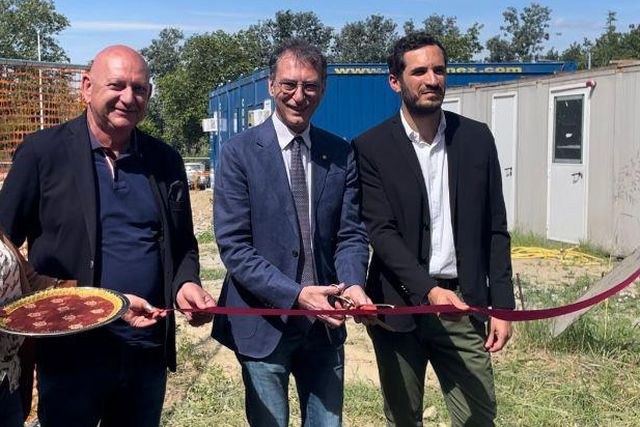Construction work begins on the new campus development project in Cesena
Rector Giovanni Molari, the Mayor of Cesena Enzo Lattuca and Campus President Massimo Cicognani, were among the attendees at the inauguration
The inauguration ceremony was held this morning at the site of the building that will house the Department of Psychology, classrooms, teaching laboratories and the campus administration offices. The building marks the completion of the university campus built on the site of the former sugar refinery.
"We are delighted," says Rector Giovanni Molari, "to have provided a new home for the Psychology Department, an achievement that is the result of an exemplary synergy with the municipal administration. I would like to thank the Mayor for the confidence he has shown in the University as an indispensable element in the development of the region. It is through forward-looking policies such as these that our Multicampus - the only one of its kind in the country and of which we are very proud, can become stronger, more solid and more attractive. We are confident that we will soon be able to find the resources to complete this work on time."
"This is a project," comments Mayor Enzo Lattuca, "in which we believe strongly, and which reinforces the role that the University has played in Cesena for thirty years. It was in the autumn of 1989 that the challenge of planning the first University presence in the city was taken up. This was despite a major economic commitment that was confirmed in subsequent years. Today, this new construction site, which will provide us with the new premises for the Department of Psychology, is the third stage of a development project. It began with the construction of the Engineering and Architecture Campus in Via dell'Università 50 and continued with an investment of €7 million by the City Council and the transfer, by the Authority, of the surface rights of the area on which the student residence has already been built".
The building will house teaching spaces, laboratories, administrative front offices and studies. When fully operational, will provide space for approximately 2,000 teachers, researchers, students and technical-administrative staff. The works inaugurated today will result in a building of 9,750 square metres.
The facility will form part of the campus, which is located in an environmentally valuable setting on the banks of the Savio river park. The overall intervention was made possible thanks to the Urban Redevelopment Plan (PRU), which has been promoted by the Municipality of Cesena together with the Ministry of Infrastructure and Transport (MIT) over the last twenty years, with the University of Bologna participating through a programme agreement signed in 1999 with the then Ministry of Education, University and Research (MIUR) and the Municipality of Cesena.
The new building, designed primarily by the University of Bologna Technical Office, will follow the architectural language expressed in the detailed plan. It will be characterised by exposed brick on the lower level, with specific areas on the upper floors clad with stoneware panels to emphasise its importance and uniqueness in relation to the other buildings in the context. It will consist of three storeys and an underground car park for staff (in front of Piazza Sciascia and at the corner of Piazza Sciascia and Via Vico) and will contain teaching and research space for the Department of Psychology as well as areas for campus administration offices. It will house the Student Secretariat and Archives, which are currently located in Palazzo Urbinati.
The entire building will be green, as the executive project includes technical choices aimed at reducing energy consumption and maximising the use of clean energy sources, thereby limiting the environmental impact of the intervention both during construction and during use. The building will be heated via the district heating network, while the summer air-conditioning system will be based on high-efficiency compressor chillers, which will also contribute to winter heating thanks to their reversible heat pump. In order to reduce the temperature of the hot water distributed to the rooms and to increase the energy efficiency of the heating system, the large classrooms will be heated by a radiant floor heating system. The use of an intelligent control system, combined with air treatment units for the most heavily used rooms will make it possible to limit the energy consumption associated with ventilation. A network of presence and temperature sensors distributed throughout the building will activate forced ventilation only in the rooms that are being used, and will allow free cooling of the internal spaces, avoiding the activation of cooling units every time the thermo-hygrometric conditions of the outside air allow it.
The solutions adopted and the choice of envelope elements will ensure optimal internal conditions in terms of thermo-hygrometric comfort and air quality.


